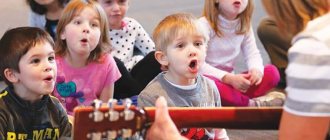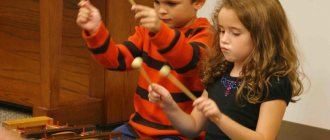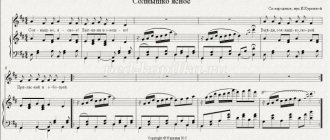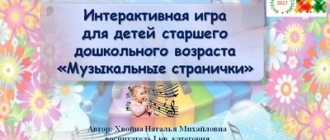Didactic games for children during music lessons
Musical games to develop a sense of rhythm in children of the preparatory department and the first year of art school
Author: Vera Olegovna Sedova, piano teacher, accompanist of the MDUDO Children's School of Children's Art School, branch in the city of Dmitrov, Moscow region Description. I offer game material for developing a sense of rhythm in children of the preparatory department and the first year of art school. This material can be used by teachers and music directors of preschool institutions, teachers of general education and music schools, parents and children themselves from five to seven years old. Goal: developing a sense of rhythm through musical creativity. Objectives: 1) teach children to listen and hear the rhythm of music, distinguishing between long and short sounds; 2) develop the child’s curiosity, ingenuity, thinking, memory, attention, imagination; 3) cultivate interest in creativity through children writing original assignments. The game is an integral part of the educational process. It helps to understand and consolidate knowledge about the material received, arouses interest, develops imagination in children and adults, turning students and teachers into co-authors of a single creative process. I offer games that I often use in the educational process at the first stage of education (preparatory and 1st grades of a children's art school), and I use them at concerts for parents so that they can see the growth of their child and can help him if he has difficulty completing his homework. I. Game “Repeat the rhythmic pattern” 1 version of the game Purpose: development of a sense of rhythm, hearing, memory, imagination, speech; give a simple idea of the length of sounds (long, short). Description. The teacher taps the rhythmic pattern of the melody with his hands or a pencil on the table, and the child repeats. Then the child comes up with a rhythm, the teacher repeats, and the student checks whether the task is completed correctly. Example.
The teacher recites the poem: Ta, ta, two cats... The child beats out the rhythm of the poem with his palms (or a finger on a key, a pencil on the table, a hand on the instrument cover, a hand on a tambourine, a stick on the key of a metallophone):
Questions for task
1. How many sounds do you hear? 2. Where are the short sounds: in the middle, at the beginning or at the end? 3. Where are the long sounds: in the middle, at the beginning or at the end? 4. How many long and short sounds did you hear? 5. Choose the correct scheme from those proposed:
2 version of the game
Purpose: development of a sense of rhythm, hearing, memory, imagination, speech; give a simple idea of the length of sounds (long, short). Description. The teacher suggests tapping the rhythm according to the table:
Questions for the task
1. Tap the rhythm on your hands and say the text.
Distinguish between long and short sounds in your voice: draw out long ones, pronounce short ones quickly. 2. Draw a diagram of notes for any verse (child or teacher’s choice). Example.
Ding, dong, ding, dong, There's an elephant walking around the zoo. The child a) recites the verse and beats out the rhythm with his hands; b) determines by ear the number of long and short sounds; c) determines their location (at the beginning, in the middle, at the end); d) writes down the outline of the verse in notes - circles.
3rd version of the game
Purpose: development of a sense of rhythm, hearing, memory, imagination, speech; give a simple idea of the length of sounds (long, short), types of sounds (noise and musical). Description. In this task, notes are written in black and white circles, as an option for first grade children. The task contains a riddle. In this task, you can repeat the questions from the second version of the game, or you can experiment with noise and musical sounds: the child knocks the rhythm in an invented way (For example, he beats long sounds with his foot, short sounds with his hands, the teacher guesses whether these are noise or musical sounds, repeats after the child task, the child checks the completion of the task, then the teacher suggests the task.)
4 version of the game Musical game “Colored Keys” Purpose: developing a sense of rhythm, hearing, memory, imagination, speech, obtaining a simple idea of the length of sounds. Opsaniye. For this game, your child will need a color keyboard,
based on which he will be able to play independently,
and also come up with your own unforgettable melodies with original poems, in the composition of which a teacher, parents, and older comrades can help. You can process the material created by your child in the Adode Photoshop program, create a personal instrumental album in paper or electronic form, and also prepare a presentation of this album with pictures and sounding melodies, record works performed by a young author on a disc, which is a nice gift to give to your mother, grandmother, friends. II. Game "Let's go!" Goal: development of a sense of rhythm, hearing, memory, imagination, speech, consolidation of knowledge about the duration of notes. Description. Game "Let's go!" - to consolidate the material when studying note durations. Children enjoy “riding” on trains. You can make carriages from colored cardboard, use different sizes in the game (2/4, 3\4, 4/4/, 3/8, 6/8, 9/8), smaller durations (sixteenth, thirty-second), give it to your child try to fill the trailers yourself with durations in accordance with the proposed size.
III. Game “Songs on Stairs” Purpose: to develop a sense of rhythm, hearing, memory, imagination, speech. Description. The game “Songs on Ladders” is another version of a rhythmic exercise with changing the pitch of sounds. Here the child learns to navigate the keyboard by changing the pitch of sounds in accordance with the picture. There are many options with a diagram. Example:
a) you can ask the child to look at the diagram in red and determine the direction of the melody (first up, then down); b) determine how many short sounds and long ones (two short, 3 long), where they go: up or down (3 sounds up, then two down); c) play a melody on the instrument from sound to (options: from D, from F, from B); d) clap the rhythm of the melody and choose words for it (I'm going for a walk); e) come up with your own ladder, draw it in an album, and compose words.
I use the games proposed in the development during the pre-notation period of teaching musical notation, which takes from a month to three, depending on the age and abilities of the child, his interest and activity. Games help to captivate the child in learning, and give the teacher room to develop his own imagination and the opportunity to use the reserves of his creative talent, implementing the slogan “Teach while playing!”
We recommend watching:
Winter musical games for children 5-9 years old Didactic materials for the preparatory class of the Children's Art School with a presentation Methodological guide to the development of musical and rhythmic abilities in children 6-8 years old Master class for parents of the older group. Musical games for children 5-7 years old
Similar articles:
Musical games for high school students






